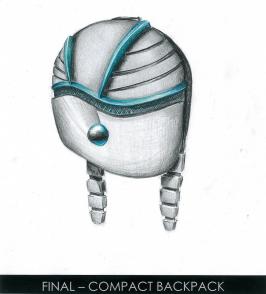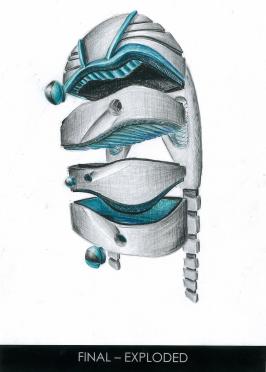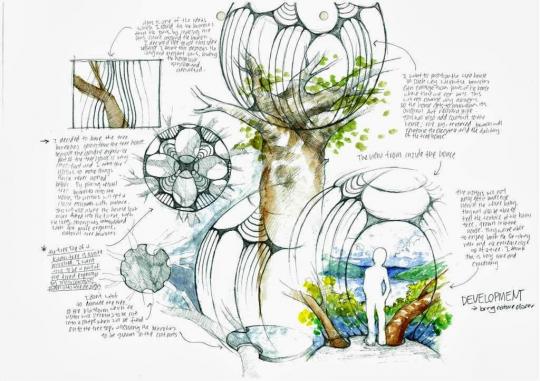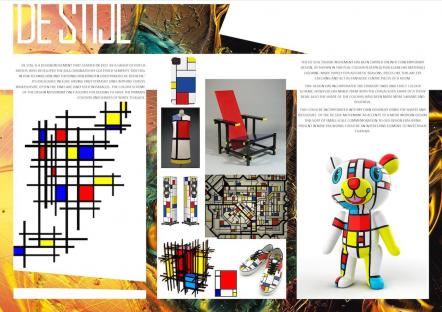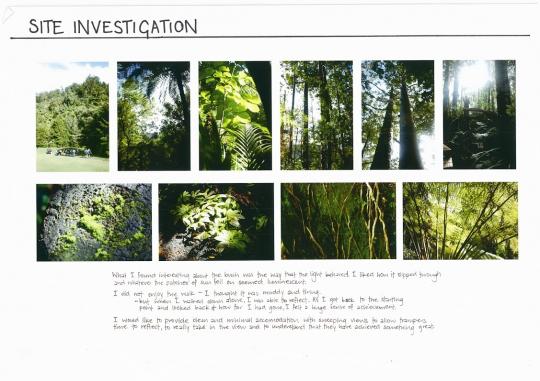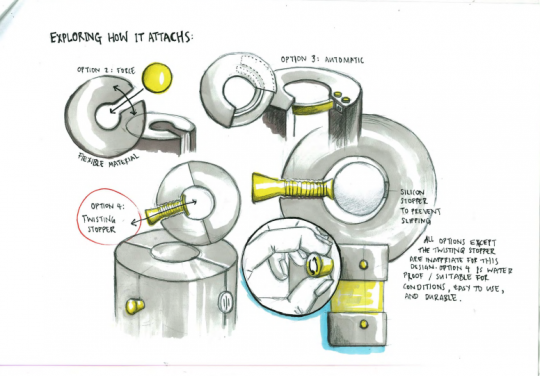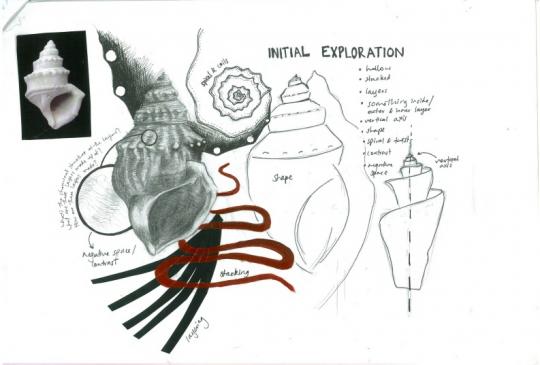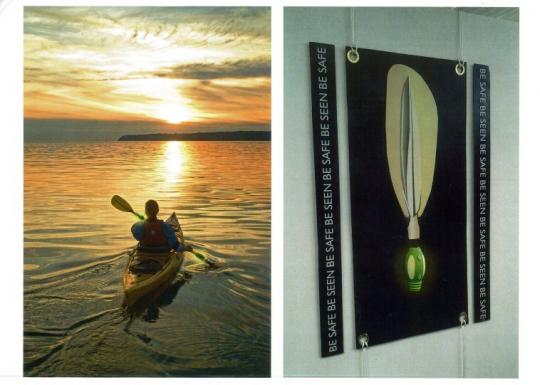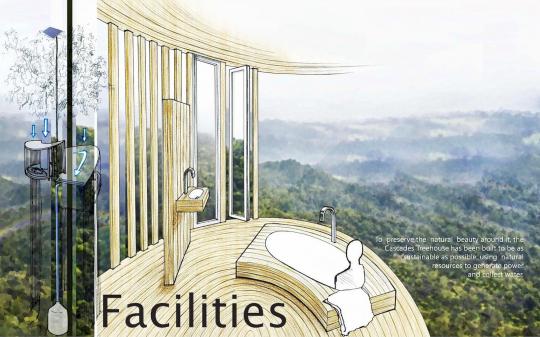Teachers talk about DVC Scholarship
Teaching inquiry
How do I help my students to be successful in DVC scholarship?
Introduction
In this Scholarship resource, a group of graphics teachers with continued success in Design and Visual Communication (DVC) Scholarship describe their teaching strategies and approaches. They also consider the changes they have made to their teaching programmes to align with the new 2013 Scholarship standard.
Teachers Megan (Epsom Girls Grammar School), Ron (Onslow College), and Motu (Saint Kentigern) share their comments and recommendations in the following areas:
- Prior learning
-
Introducing students to the Scholarship DVC standard
- Innovation
- Design thinking
- Visual communication
- Client or no client?
- Classroom environment
- CAD
- Is it up to scholarship standard?
- What next?
Background
As a result of the standards alignment process, the Scholarship standard for DVC changed from 2013.
The key changes include:
- A move to design ideation and graphics practice as well as visual communication
- A new refined standard with clear expectations and a new assessment schedule.
For sample resources, see NZQA: Scholarship Design and Visual Communication Sample Resources
Prior learning
Megan
We offer DVC from year 10 (not year 9). Students generally need to start at year 10 although we do negotiate exceptions.
Motu
Every student does a DVC block course (about 22 lessons) as a part of our year 9 technology rotation. DVC becomes a full year option from year 10. In year 11, the majority of our students have also done year 10.
Introducing students to the DVC Scholarship standard
Megan
The marking schedule gives useful detail on the changes to the Scholarship standard and is the best place to start. The descriptors within the three headings and the clarifications of terminology give a good idea of what is expected in the standard.
Ron
I start with the marking schedule in the workshops and classes that I run on Scholarship. I help the students unpack Ideation, Graphics Practice, and Visual Communication. The way the Scholarship schedule now links to the learning objectives of DVC is a positive move.
Innovation
Megan
One of the questions I’ve asked myself is how to get students to be innovative and carry out projects that lead to something new and/or different – something original or something renewed in terms of aesthetics or function.
Starting the year by asking students to come up with their own idea does not work for us. We saw talented students struggle because they just couldn’t come up with an idea.
Surprisingly, giving students a project with some constraints or walls or boundaries seems to provide them with freedom because it allows them to get going in their own direction by bouncing their ideas off the constraints. We do let students go off in another direction, but we always give them a starting point.
I find that to support innovation you need to set design projects that have an element of discomfort or difficulty so that students are forced to go beyond commonplace ideas.
Working with your students is key. Our students are inner-city urban girls. One project I have had success with is designing a tree house in the Waitakeres for people to stay in. The students actually tramp to the location one afternoon. This gives them an opportunity to feel the place and what it is like in this type of environment – the birds, the plants, the cold. They can look at the views, hear the water, and imagine what they would want people to experience in the tree house.
The tree house project has a good combination of emotional experience with a strong aesthetic and with technical and functional considerations.
The tree is surrounded by other trees and requires a lot of thinking about structure and access issues.
Ron
I find that the new Ideation standard (AS 91627 Initiate design ideas through exploration) provides a good starting point for project briefs.
Using different experiences, a range of source material, and existing designers gives a starting point for students to generate ideas for their own briefs. I oversee their choices and encourage them to come up with a context that is achievable.
Motu
With the DVC standards, I have been developing creative activities that are not too closely linked to the brief or any pre-determined outcomes. Rather, I work on developing lateral thinking strategies. This often involves experimentation in a visual media (mock-ups, sketching, collages, digital modeling, and so on) that work from themes and/or words. I think layers of meaning, play, and the use of language devices as well as visuals are some things that I tend to encourage.
into the students’ own interests and approaches is key. At year 13 I encourage students to undertake their own individual project. In my opinion, innovation is not a formula, but rather manifests in many ways. The challenge for me as a teacher is to unlock the innovation from each potential Scholarship student. The new DVC standards have certainly helped provide more opportunities to do this.
Design thinking
Megan
As a department, we have been investigating how to stimulate design thinking rather than just following a design process. Our research into this has shown that there are different types of thinking required to complete a design project. Students also need a range of resources and activities so that they can find one they personally connect with.
Empathy is one of the aspects of design thinking. We see this as not necessarily empathy with the client or stakeholder, but rather the way the teacher can create empathy and connections to a design project for all students. This year, for example, we trialled an additional angle with the tree house design. Traditionally, we have looked at the history of the area and tramped to the site. Many of our students have never tramped before and find the afternoon tramping to the site in the Waitakere’s a very different experience (and out of their comfort zone). This year, before the tramp, we had a talk from fellow students involved in the Duke of Edinburgh Awards. They shared their tramping experiences with the class, discussing aspects such as what they like and dislike about going on a tramp, tramping huts, what’s uncomfortable about staying in the bush, and the clothes that trampers wear. For some students, this added another level of empathy to the design project and enhanced their tramping experience.
Another aspect of good design is creativity. Again, one activity does not suit all students. We look at many examples of different types of architecture and offer a range of sketching and modelling activities.
We like to encourage the students to be hands on and play with modelling materials to create ideas. A new team competition this year encouraged students to use their hands and physically manipulate material as part of modelling. I split the class into groups of four and provided each team with a model tree trunk, paper, wire, plasticine, tape, and a camera. Each group had to create and photograph as many different quick tree house models as possible in 40 minutes. The prize went to the group who created the most models. This activity emphasised that quantity and speed of ideas is an important factor in getting ideas flowing – “Don’t think about it, just do it!”
We try a range of sketching activities to develop creativity. For example, we have the students start sketching in the bush, picking up pieces of bark and drawing from them.
Our theory is that if you have empathy and some effective ideation occurring, then the critical thinking will follow naturally from this. If students are inside the design situation, they will ask the right questions – design questions rather than “How many pages do I need to do?” Then we know they are on the right track. If not, we need to do some further teaching.
I have started to put together a pinterest board on design thinking. Google research has produced a lot of resources on design thinking.
Ron
An important part of design thinking is the narrative that underpins the design story. Structuring the project so others can follow the design thinking is very important. Sometimes my students go off on tangents that don’t appear to link back to the project, or they leap ahead – not communicating stages of their design thinking. I have to remind them (and myself) that markers are seeing your work for the first time and have to be able to follow your thinking.
Motu
Design thinking is more about the ideas and how they evolve, rather than just a sequence of alternatives or changes. Having a design narrative is a nice way to see it. The thinking needs to be purposeful and meaningful – but it will not always necessarily be linear. At times the ideas may go around in circles, at times linger or hit a dead-end, and at other times leap forward rapidly.
At the end of the day, there needs to be some purposeful progression and there needs to be a train of thought that can be read by the marker.
Design thinking done really well isn’t bound to just solving all the specifications in themselves. It extends beyond these and integrates the many facets of the design situation (in the brief and beyond the brief) in a coherent and eloquent manner.
Visual communication
How can I ensure that design thinking is comprehensively communicated using visual techniques and/or strategies and visual presentation principles and skills are outstanding and employed in a manner that has visual impact?
Megan
Projects have to be able to draw well and look visually strong so that students can create their own angle. We often have very minimal writing in our submissions.
The project has to allow the student to get absorbed in their own journey or use their own strengths or interests so that they can hook onto their own way of doing it.
For our product project, we used to start with explaining they need to develop a lighting product and the outcomes were so predictable and not dissimilar to the lights in the shop across the road! Now, students are asked to find an object of inspiration and explore it through drawing or modelling. Once they have explored it extensively, they are asked to design a lighting product around it. This also fits nicely with the ideation aspect of the level 3 standards.
With this approach, the students have come up with interesting products that are far more interactive. One innovative example was the designs of a student who was interested in bones, became particularly interested in the human spine, and then designed a light around this. This year a student explored jellyfish and the way they float about in the sea and was also interested in the divers that died at Lake Pupuke and designed a safety light for divers. Another student was interested in shells and has come up with a safety light that goes on a kayakers paddle to alert others in the early evening or at night.
We get better creativity from the students setting out not knowing where they are going or will end up. Diving into the unknown is useful at scholarship level. You often hear that good designers make unusual connections so it is about teachers creating an environment for students that this will occur.
Motu
In class I constantly refer to this aspect of DVC as “advanced Pictionary”. To be successful, the drawings need to explain the design thinking and narrative, and explain the ideas generated accordingly. You shouldn’t need to read paragraphs of annotation to make sense of the drawings. This also means that the arrangement of the drawings needs to help tell the story.
The students need to work to their strengths. For example, I had a student who had never achieved the top results at level 1 and 2 and this was because he always used freehand sketching for his design work. When he used CAD for his presentation work, I saw he had some amazing digital skills. In level 3, I encouraged him to use his computer skills for his design work and this became his main mode, although he provided plenty of sketches as well. The difference was dramatic, and he was liberated as a designer. Students need to be able to operate in the mode that best allows them to visually express their thinking – using physical models, digital, freehand sketching, or instrumental drawing. We know that drawing ability can be a significant barrier to the generation of ideas.
Client or no client?
Megan
We have stopped using a client/stakeholder. This was a big change for us. However, we were finding that client interaction inhibited the students and restricted their creativity and innovation.
Motu
Using a client up front certainly compromised the creative and divergent starts to projects, and as a result, students tend to not be able to be so innovative in their approaches or ideas. I am certainly happy to move away from having a client altogether. But if there was a student who had a meaningful brief that involved a client, then I would encourage that.
Not having the client negotiation standard has freed up what students can do. Having legitimate client interaction is very sophisticated and quite an undertaking for students – and dependent on a client with a truly vested interest in the project. It also demands a lot of students as novice designers to be able to prompt the necessary feedback from clients to make truly effective design decisions and not just simply respond to what the client says.
Classroom environment
Megan
We keep an extensive in class library with a good supply of books and magazines that are relevant to each project.
Students have ready access to modelling materials and equipment – foam, plastacine, card, paper, craft knives, and so on. For the tree house project, we have some tree trunk models for students to stick ideas onto.
We foster a culture of sharing and displaying student work on the classroom walls. We also keep a past project drawer – with exemplar material available for each level. Success breeds success!
Motu
A library of inspirational design books is a big thing as well as design DVDs (although YouTube is good for this too).
My classroom walls tend to have inspirational and informative images rather than student exemplars. I also have design work from different design fields – fine art, sculpture, and graphic design as well as furniture design and architecture.
Our department moved away from having student work up in the classroom, to having these kept in clear files in the classroom. I found students who wanted to actively look at student exemplars were happy to look through the clear files. We have some good shelving also for our models and mock-ups. I am looking at investing in some nice display cabinets in the future.
CAD
Megan
The CAD room sits between the two 2 graphic classrooms. At any stage, students can jump onto SketchUp or SolidWorks and check out what is happening with their ideas. It is very helpful for scholarship and level 3 to be able to use these to draw up and present their designs. We realise that there was a lot of stress around this for students so we start off simply in year 10 using CAD and give them an opportunity to build on this each year so that they get more comfortable with it. Once they master it, they do get used to the extra capability it gives them.
Alongside this we have created a number of on-line tutorials for this and other aspects of graphics teaching using Jing.
We have found that this helps students because the instruction is available on a need to know basis and we find this is an effective way of learning about software packages. It also teaches students to learn about using online instruction, which will help them if they go on to University. We have found having prepared tutorials has reduced the stress on teachers too. We tend to make them in batches – some we have used for three years now.
Is it up to scholarship standard?
Megan
When I look at their work, how do I know if they are in with a chance of scholarship?
I generally teach to scholarship for all students. Then at the end of term 2, I ask students to indicate whether they would like to submit their project for scholarship and I give them further guidance.
I have a checklist when I am looking at their work.
- Do they have interesting ideas that are a bit different or new?
- Is there a clear design journey from research to ideation to final stage, and is that journey visually recorded?
- Does the design address both the aesthetic and the functional issues?
- Is the excitement or interest still there and captivating in the final design?
- Does the final idea really resolve the issue?
Motu
I do endeavor to map the schedule onto the students’ work during the year, though sometimes it is too hard to predict when the project is only half done. I tend to find that you can only really see whether it is a potential scholarship when it is virtually complete. At the end of the day, it is quite often about being the complete package, and some projects will only make sense when seen in their entirety. Things do have to go well too, and sometimes things that start well don’t carry through to the end.
The use of past scholarship projects as exemplars is useful, although these examples have also highlighted that the standard has been steadily improving year after year.
What next?
Megan
Students are still captivated by the tree house project so we have kept going with this. However, we have introduced a couple of alternatives this year.
The student work in DVC scholarship does seem to be getting more interesting and innovative and the students’ presentation seems to be getting more sophisticated. This could be as a result of both the students and new teachers coming through.
Motu
We are still developing our programmes in line with the emergence of the DVC suite of standards.
Our year 9 block course is pretty set now and has been put into a form that any technology and non-DVC teacher can deliver.
Our year 10 programme is being refined after some significant recent changes. There are creative tasks that set up each brief, and the major house design project is very popular with the students.
Our year 11 and 12 programmes are well set up to suit the DVC curriculum. And the year 12 programme has been developed so that some students can give scholarship a go without having to do something different.
Year 13 has required some refining after the first year. We are excited about the prospects of some even more amazing work coming out, especially in the area of architecture.

